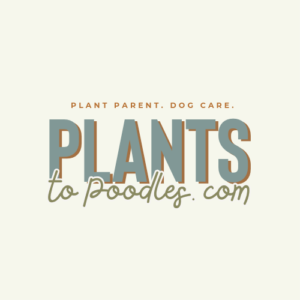You just bought your first house plant and have decided you are going to give your green thumb a try.
After carefully inspecting your new house plant friend you find when you pick it up its roots are growing out the bottom of the flimsy plastic pot it came in. You are correct to think you need a new pot for your house plant immediately.
It is best to go ahead and repot your plant within the first 24-48 hours after purchase.
I am not sure if you are overwhelmed with the huge selection of pots available in the past few years, but I sure was when I first started shopping for plants, and the selection continues to grow.
So, what pot do you choose? Let’s talk pots! Is my number 3 rule of beginner’s level rules to plant parenthood. Becoming a new plant parent, you want to make the right choices for the survival of your new house plant.
Check out Beginner’s Level Rules #1 and #2 here.
5 things to consider when selecting a pot.
1. Size
Most of the time pots for house plants are measured in inches. I have pots in a variety of sizes ranging from 2” (tiny pots for baby succulents, seedling starts, and miniature plants) up to 16” pots. I recently purchased a 16” for Marcel my Banana Leaf Tree.
A few rules of thumb for selecting the right pot size. Answering these 3 questions will aid in finding the right pot size for your plant.
What size of pot is the plant in currently?
How to measure a pot to find the correct size.
Correct Pot Sizes
Pot sizes are measured from the widest point across the top of the pot. Take a tape measure and place the hook end across the center of the top of the pot. Pot sizes normally move up in 2-inch increments. For example, if your plant is in a 2” pot you will want to go up a pot size to a 4”, if in a 4” go up to a 6”. Most plants will fit comfortably in the next size up.
Here are pots 2, 4, 6, and 8 inches.

You can sometimes go up 2 sizes (for example going from 2” to 6”), it is safe to do so if the plant’s foliage is about as tall as the pot it is going into.
Here is an example:
My Rosemary plant was in a 4” pot at the time of purchase, her foliage is about 7 inches in height, so I chose to repot her into an 8-inch pot.
Other times this rule applies is having a top-heavy plant. Snake plants are a good example of this. The roots on a snake plant are tiny compared to its thick heavy leaves. The reason being is snake plants are succulents and they hold water in their leaves. In this case, you will need a larger pot to help stabilize the plant.
Another thing to consider.
What time of year is it?
If the plant is going into its growing season you may opt for the 2 sizes larger pot since the plant is going to grow a lot over the next few months. If you only go one size up, you may have to repot again at the end of the growing season.
However, if you have purchased your plant in wintertime or during the plant’s normal rest period, the plant will be best repotted in one size up.
Also, know.
What type of plant is it?
If you want to get technical, research on the type of plant you have and find out how its root system works in its natural habitat. Plants thrive most in environments most like their natural. Here are a couple of examples of times you will want to research further.
A good example of when pot sizes vary from the norm to better suit the plant’s natural habitat needs.
Phalaenopsis Orchids grow on trees and grow aerial roots that can grow as big as their stems. These plants love being pot-bound, meaning they prefer to fit a little tight in their pots because their aerial roots grow up and out of the pot anyway. Only go one pot size up with Orchids after purchasing.
Also, if you have ever seen the root system of most succulents you know they are tiny. Consider purchasing shallow pots for succulents. Shallow pots come in all the same pot sizes as other pots 2” and moving up in 2” increments, but they are about half the depth of other pots.
The purpose of shallow pots is to help prevent root rot, which is what happens to a plants’ roots when left in soggy soil. That is why planting succulents in shallower pots is a good idea to help prevent this.
The best size of pot for your plant
Best practices when choosing a pot size are selecting one to two sizes larger than the size of the pot it is purchased in. Consider the time of year, will the plant be growing rapidly over the next few months, if so go up 2 sizes and just be careful when watering. For more tips on watering your plants
Insert newsletter sign up.
Also, stay tuned for more of my Beginner’s Level Rules!
Now that you know what size of pot you need, what shape is appropriate for your plant.
2. Shape and Material
Air Pots
There are many different shapes of pots to consider. Air pots are a good option. These pots are designed to help keep the plants’ roots from growing in the round pattern they form in standard pots that causes them to become root bound.
Air pots aid in keeping pots from becoming root bound. The flaw with air pots is they are not decorative. However, you can place them in a rope basket. This look is trendy. I am going to get an air pot and a rope basket for my Majesty Palm.
I have not gotten this palm yet. It was a start off my brother’s plant and every time I visit him, I forget to take it. It is not just a start anymore, the last time I visited, and forgot it again, it was a big plant. More on air pots in the future, stay tuned!
Terrariums are exceedingly popular as well. These are glass and come in different shapes and sizes. Miniature plants, air plants, and succulents do well in these.
Plastic vs. Terra Cotta

Plastic pots are better for plants that need more humidity or can survive high levels of humidity. Tropical plants are a good example because these plants love humidity. The reason plastic is better suited is that plastic retains water longer than terra cotta, because it is not porous like terra cotta.
Terra Cotta pots, on the other hand, are excellent for cactus and succulents, because they do not retain moisture for long. These pots dry out quickly, therefore; if you do place tropical plants in them it is ok, you just have to remember to water more frequently. Always remember to research your type of plants watering needs.
3. Function
A pots function is simple but important!
Here are 3 examples of how pots function.
A good drainage system, to prevent root rot.
Pots need to have a drainage function. The simplest is just a hole in the bottom of the pot.
Ok, l will share a little secret here. I did not know that plastic pots have a place to punch out holes for drainage in the bottoms, for a long time. The reason I am sharing this secret is two-fold.
For one, I know this is useful information to someone out there?? Hello, anyone? Ok, I will keep your secret safe.
And two, some plastic pots do not have these punch out templates readily available. If the pot does not you will have to form another way for the water to drain. Place a self-water wicking plate in the pot’s bottom, it functions like a strainer allowing the water to run out from under the soil.
Self-watering Wicks
These are a good tool for watering your plant. The wick is corded cotton. Place one end in the soil and the other through the drain hole. Put the bottom end of the wick in water and it will water your plant. This function is good for African Violets.
African Violets do better when watered from the bottom of the pot to avoid getting their fuzzy leaves wet. They also like to dry out quickly, therefore; letting their roots and the help of the wick do the watering to prevent overwatering them.
Self-watering pots
I purchased three self-watering pots this past summer and one has been Ivy’s, my Pothos, lifesaver. See my plant short story Ivy Gets a New Pot coming soon! Self-watering pots allow the plant to soak the water from the bottom of the pot through their roots. They work very well for plant parents that tend to forget to water. Once you feel the outer pot up the water level will show max, this amount normally lasts up to 2 weeks.
They also aid with plants that have suffered trauma, such as, improper watering or wilting from too much sunlight. The only flaw I have found, so far, is the roots of my plants are growing down through to the water. I don’t know if this is a flaw, but I may have to trim them back.
4. Color
When the Color of the Pot Matters
Color really doesn’t matter most of the time. There are some circumstances when the color of the pot does matter. If you put your plants outside in summertime color can matter, because darker-colored pots, like black and navy, heat the soil to higher temperatures than white and lighter shades do. You will want to take into consideration if the plant is heat sensitive.
Most plants can withstand temperatures up to 90 degrees without suffering any heat distress. Leaves will start to wilt if the plant is getting too hot. It is ideal to consider lighter colored pots for patio and deck planters, also for your plants going out into the summer temperatures. If you do decide to plant in a darker color, be sure that you can move your plant to a shaded area in the hottest part of the day.
5. Plants as Home Décor
A lot of times when you purchase a plant you have a vision for it. You want to start a small kitchen herb garden, you may want to hang a few plants in front of your windows, or you want to decorate for the holidays with traditional plants. Researching your plants’ needs is essential. There are so many articles on Pinterest and Google to research different ways to display your plants in your home.
What pot is right for you and your plant?
Determine the correct size, shape, and material for your plant. Research the type of plant you have and what its specific needs are. Remember if you are placing it outdoors color may play a factor. And of course, your vision for your plant and how you will display it is important.
I would love to hear the vision you have for your plants. Please share your visions and ideas for your plants with me here.
I hope this has helped inspire you to choose the right pots for your plants!
Stay tuned for Beginner’s Level Rule #4: Digging in Soil, to find out exactly what type of soil is right for your plant.
Until next time!
























